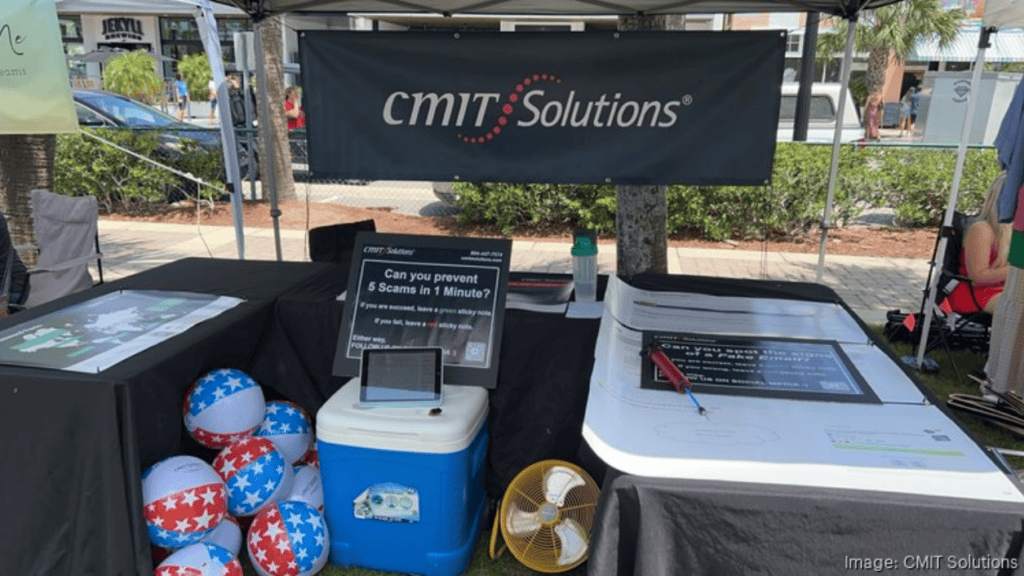- Small and medium-sized businesses are frequently targeted by scams—phishing, invoice fraud, tech support scams, and impersonation scams—that employ unique tactics to deceive businesses and access sensitive information.
- There are red flags to help identify scams (such as urgent language, strange links, and unexpected invoices) to watch out for, and strategies like employee training, implementing verification processes, and using cybersecurity tools can help prevent attacks.
- SMBs can maintain vigilance, establish security protocols (like multi-factor authentication and DMARC), and work with verified IT support to protect against these cyberthreats.
Small and medium-sized businesses (SMBs) are vulnerable to a growing number of scams, especially with how digital businesses need to become to make their way in the world. Whether it’s phishing, invoice fraud, or impersonation schemes, scammers are constantly evolving their tactics.
To help you out, here are some of the most common scams targeting SMBs and the ways to recognize and prevent them from taking advantage of your business.
Phishing Attacks
In a phishing attack, scammers impersonate a trusted organization or individual, often through email, to trick recipients into revealing sensitive information. These emails may contain links that direct users to fake websites where they’re prompted to enter passwords, credit card numbers, or other personal details.
Here are some tips to help you spot a phishing email:
- Suspicious Sender Address: Check if the email address closely matches that of a reputable company or individual.
- Urgent Language: Phrases like “urgent action required” or “account suspension” are common tactics.
- Strange Links or Attachments: Hover over links before clicking to see if they lead to legitimate websites.
To protect your business, educate your employees to recognize phishing attempts and encourage them to double-check links and attachments. Use email security software that filters out suspicious emails and alerts you to potential threats as well. For an added cybersecurity bonus, implement multi-factor authentication (MFA) on important accounts.
Invoice Scams
In an invoice scam, a fraudster sends a fake invoice to your business, hoping you’ll pay it without a second thought. These invoices are often designed to look like they’re from vendors or suppliers you regularly work with. Small businesses are particularly vulnerable because of their typically smaller accounting teams.
Common signs of an invoice scam include the following:
- An invoice arrives for a service you don’t remember ordering.
- There may be slight differences in logo, vendor name, or contact information.
- Scammers often emphasize an urgent deadline to rush the payment process.
Keep your business safe from these scams by verifying invoices by contacting the vendor directly using known contact information. Implement a double-approval process for payments above a certain amount as well, just to be safe. You can also keep detailed records of all vendors, services, and invoices to cross-reference.
Tech Support Scams
Tech support scams often involve unsolicited calls or pop-up messages warning of supposed issues with your business’s systems. The scammer claims to be from a legitimate tech support company and urges you to pay for unnecessary or even harmful support services.
Keep an eye out for these things to catch this type of scam:
- Unsolicited Calls or Messages: Reputable tech companies will not contact you out of the blue.
- Requests for Remote Access: Scammers ask for remote access to fix non-existent issues.
- High-Pressure Tactics: They push you to act immediately, claiming your system is at severe risk.
This type of scam can be prevented easily by working with a verified IT support provider that you’ve personally contacted. You can also train employees to ignore unsolicited tech support calls and report them.
Business Impersonation Scams
Impersonation scams are on the rise, with scammers pretending to be from your company to steal customer or vendor information. They may use fake emails, websites, or social media profiles to trick people into thinking they’re interacting with your business. This can harm your brand reputation and expose sensitive information.
Scammers involved in business impersonation scams may create accounts that look like your business and interact with your customers. They impersonate your business email domain to phishing customers or employees. They may also create a website that mirrors your real one to deceive visitors.
Regularly monitor your online branding for fake profiles and websites to stop this scam dead in its tracks. Use DMARC (Domain-based Message Authentication, Reporting & Conformance) as well to protect your domain from email spoofing. Take the time to notify customers and vendors about your official communication channels and encourage them to report suspicious interactions. These actions engage your customers and let them help keep your business safe for you!
Payroll and HR Scam
Payroll and HR scams specifically target employee data and payroll funds. In one common scam, a fraudster might impersonate an employee and request a change in direct deposit information, redirecting salary payments to their account.
These are some warning signs to watch for when it comes to payroll scams:
- Unusual Requests for Changes: Unexpected requests to update payroll information without a clear reason.
- Lack of Verifiable Contact Information: Requests are made via unofficial channels, such as social media or personal email addresses.
- Suspicious Timing: Fraudsters often initiate these scams around payroll periods, hoping to blend in with normal processes.
To prevent this type of scam, set up a two-step verification process for payroll and banking changes. Inform employees about common payroll scams and encourage them to report suspicious requests too, and regularly audit payroll processes to catch unauthorized changes quickly.
Fake Charity Scams
Scammers sometimes pose as charitable organizations, especially after major events or disasters, hoping that businesses will donate without doing due diligence. These scams can range from fake donation requests to entire websites mimicking legitimate charities.
Fake charities can be spotted by looking for vague details about how donations will be used. Scammers may also use urgent appeals to rush donations. Other red flags that indicate a scam are requests for wire transfers or gift cards.
Verify the legitimacy of any charity before making donations. Check if it’s registered with recognized charity databases like Charity Navigator to further check for validity, and encourage employees to avoid impulsive donations on behalf of the company. To be safe, set a simple policy for company donations that involves proper vetting and approval.
Social Engineering Scams
Social engineering scams manipulate people into sharing confidential information. Scammers might pose as legitimate individuals, such as colleagues or customers, to gain your trust. Once they have this information, they can use it for financial gain or to carry out other scams.
Social engineering works due to these factors:
- Posing as Authority Figures: Scammers may impersonate executives or managers to gain compliance from employees.
- Pretending to Be Customers or Suppliers: Fraudsters may claim to need sensitive information to resolve an issue.
- Creating Fake Scenarios: Scammers might make up a story to elicit personal or financial details.
Train employees to question unexpected information requests, even if they seem legitimate. Implement strict protocols for sharing sensitive information, and use verification methods, such as call-back procedures, for any unusual requests.
At CMIT Solutions SW Jacksonville, we offer both IT and cybersecurity solutions for any business, no matter the size. Want to keep your SMB safe from these scams? Contact us today!




